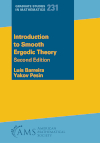- About MAA
- Membership
- MAA Publications
- Periodicals
- Blogs
- MAA Book Series
- MAA Press (an imprint of the AMS)
- MAA Notes
- MAA Reviews
- Mathematical Communication
- Information for Libraries
- Author Resources
- Advertise with MAA
- Meetings
- Competitions
- Programs
- Communities
- MAA Sections
- SIGMAA
- MAA Connect
- Students
- MAA Awards
- Awards Booklets
- Writing Awards
- Teaching Awards
- Service Awards
- Research Awards
- Lecture Awards
- Putnam Competition Individual and Team Winners
- D. E. Shaw Group AMC 8 Awards & Certificates
- Maryam Mirzakhani AMC 10 A Awards & Certificates
- Two Sigma AMC 10 B Awards & Certificates
- Jane Street AMC 12 A Awards & Certificates
- Akamai AMC 12 B Awards & Certificates
- High School Teachers
- News
You are here
Introduction to Smooth Ergodic Theory

Buy Now:
Publisher:
AMS
Publication Date:
2023
Number of Pages:
336
Format:
Hardcover
Edition:
2
Series:
Graduate Studies in Mathematics
Price:
135.00
ISBN:
978-1-4704-7065-4
Category:
Textbook
[Reviewed by , on ]
Bill Satzer
09/4/2023
This is the second edition of a book first published in 2013. Its primary motivation is to introduce a subject that is a significant part of the modern theory of dynamical systems, one that arose in connection with questions in statistical physics. The idea is to present the fundamentals of the theory of smooth ergodic systems (central concepts, methods and examples) for graduate students.
The authors – both of them major contributors to the field – note that the theory has many applications inside and outside of mathematics (from probability and statistics to physics, biology, and beyond). Their goal in this new edition is to expand and improve the exposition with more details and informal discussions. All major results are proved. They have expanded the scope to bring students closer to modern research in dynamics.
Roughly the first two-thirds of the book present the basic theory. The remainder takes up a few special topics. The expected background includes real analysis, measure theory, differential equations, and topology. The authors say that the book is self-contained, and it is – mostly – except that a reader unfamiliar with the general theory of dynamical systems would find it rather challenging.
Smooth ergodic theory, according to the authors, is about the study of ergodic properties of smooth dynamical systems on Riemannian manifolds, usually with respect to invariant smooth measures. Many classes of dynamical systems might be considered, but here the emphasis is on systems that are hyperbolic in some respect. The authors primarily consider the most general form of hyperbolicity – and the weakest – called nonuniform hyperbolicity. Very roughly hyperbolicity means that the trajectories near a given orbit look like trajectories near a saddle point. The theory of Lyapunov exponents is closely related. Roughly, Lyapunov exponents describe how orbits that begin very close to one another separate in time.
The book begins with examples of hyperbolic systems, starting with Anosov systems that show hyperbolic behavior in its strongest form and then moving on to progressively weaker forms of hyperbolicity. After this, the authors then introduce a general form of Lyapunov exponent theory in a formally axiomatic form. Then they’re off to the races with the multiplicative ergodic theorem and the theory of nonuniform hyperbolicity. Eventually, they develop local manifold theory and prove an abstract form of the stable manifold theorem.
The authors do not discuss much in the way of background. They never address, for example, what “ergodic” means, or its origin with the work of Poincaré, von Neumann and Birkhoff. Their focus is instead on an aspect of dynamical systems theory that has been developing over the last several decades, one that they believe would be valuable for new graduate students.
The treatment is complete, and certainly of value to researchers in the field and those who wish to be. There are no exercises, but a full bibliography is provided.
Bill Satzer (bsatzer@gmail.com), now retired from 3M Company, spent most of his career as a mathematician working in industry on a variety of applications. He did his PhD work in dynamical systems and celestial mechanics.
See the publisher's website.
- Log in to post comments




